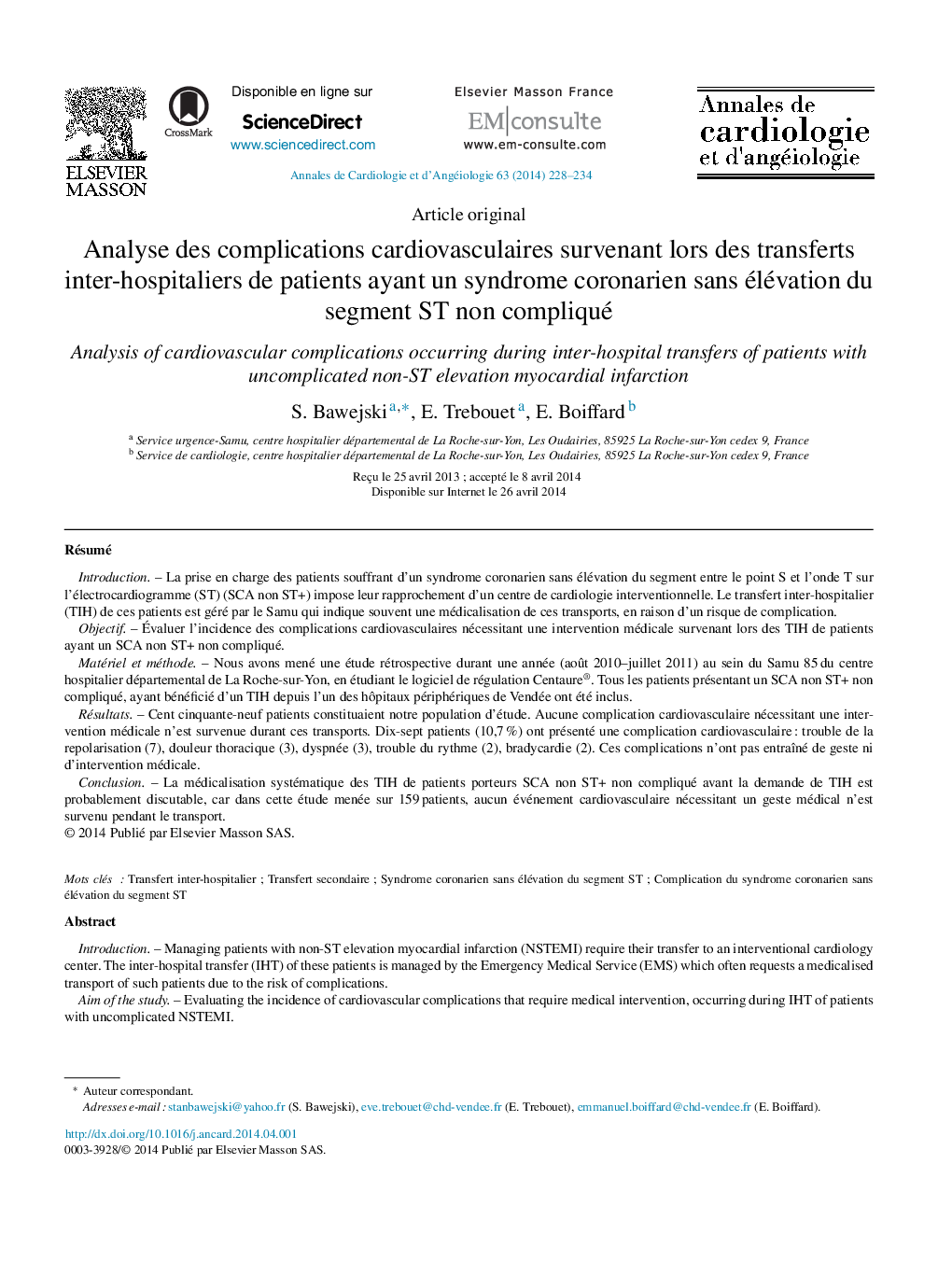| Article ID | Journal | Published Year | Pages | File Type |
|---|---|---|---|---|
| 2868736 | Annales de Cardiologie et d'Angéiologie | 2014 | 7 Pages |
RésuméIntroductionLa prise en charge des patients souffrant d’un syndrome coronarien sans élévation du segment entre le point S et l’onde T sur l’électrocardiogramme (ST) (SCA non ST+) impose leur rapprochement d’un centre de cardiologie interventionnelle. Le transfert inter-hospitalier (TIH) de ces patients est géré par le Samu qui indique souvent une médicalisation de ces transports, en raison d’un risque de complication.ObjectifÉvaluer l’incidence des complications cardiovasculaires nécessitant une intervention médicale survenant lors des TIH de patients ayant un SCA non ST+ non compliqué.Matériel et méthodeNous avons mené une étude rétrospective durant une année (août 2010–juillet 2011) au sein du Samu 85 du centre hospitalier départemental de La Roche-sur-Yon, en étudiant le logiciel de régulation Centaure®. Tous les patients présentant un SCA non ST+ non compliqué, ayant bénéficié d’un TIH depuis l’un des hôpitaux périphériques de Vendée ont été inclus.RésultatsCent cinquante-neuf patients constituaient notre population d’étude. Aucune complication cardiovasculaire nécessitant une intervention médicale n’est survenue durant ces transports. Dix-sept patients (10,7 %) ont présenté une complication cardiovasculaire : trouble de la repolarisation (7), douleur thoracique (3), dyspnée (3), trouble du rythme (2), bradycardie (2). Ces complications n’ont pas entraîné de geste ni d’intervention médicale.ConclusionLa médicalisation systématique des TIH de patients porteurs SCA non ST+ non compliqué avant la demande de TIH est probablement discutable, car dans cette étude menée sur 159 patients, aucun événement cardiovasculaire nécessitant un geste médical n’est survenu pendant le transport.
IntroductionManaging patients with non-ST elevation myocardial infarction (NSTEMI) require their transfer to an interventional cardiology center. The inter-hospital transfer (IHT) of these patients is managed by the Emergency Medical Service (EMS) which often requests a medicalised transport of such patients due to the risk of complications.Aim of the studyEvaluating the incidence of cardiovascular complications that require medical intervention, occurring during IHT of patients with uncomplicated NSTEMI.MethodsWe conducted a retrospective study for one year (August 2010–July 2011) in the SAMU-85 unit using the regulation software Centaure®. All patients with NSTEMI who had been transferred from one of the peripheral hospitals in the region of Vendee were included.ResultsThe study population group is composed of one hundred and fifty-nine patients. No cardiovascular complications requiring medical intervention occurred during the transport. Seventeen patients (10.7%) had cardiovascular complications: repolarization disorder (7), chest pain (3), dyspnea (3), arrhythmia (2), and bradycardia (2). These complications did not require action or medical intervention.ConclusionThe medicalization of IHT of patients with NSTEMI who do not show complications before transfer, is probably questionable. Indeed, according to this study made on 159 patients, no cardiovascular event requiring medical intervention was reported during transport.
